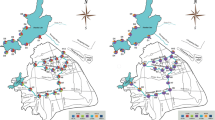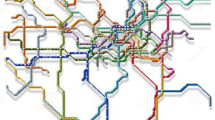Abstract
Fifty-five volatile organic compounds (VOCs) in 738 water samples collected from 33 monitoring sites in the rivers of highly industrialized urban area in Osaka, Japan, 1993–2006 were analyzed. VOCs could be classified into three groups by the detection frequency and levels of mean concentrations detected. Firstly, for 30 compounds, almost all data were non detection or were around the detection limits. Secondly, for 11 compounds, higher values were occasionally observed at some sites. Thirdly, VOCs were ubiquitously found at relatively high or high levels. Spatial distributions of mean concentrations of the most ubiquitous VOCs throughout 13 years have shown exponentially decreasing trends towards the downstream direction of the rivers. Time series of mean concentrations of all sites of five solvents have shown monotonically downward trends. In contrast, three disinfection by-products and six gasoline compounds were not decreasing.



Similar content being viewed by others
References
Glaser JA, Foerst DL, Mckee GD, Quave SA, Budde WL (1981) Trace analyses for wastewaters. Environ Sci Technol 15:1426–1435
Grady SJ (2003) A national survey of methyl tert-butyl ether and other volatile organic compounds in drinking-water sources: Results of the random survey. US Geological Survey Water-Resources Investigations Report 02-4079
Huybrechts T, Dewulf J, Langenhove HV (2003) State-of-the art of gas chromatography-based methods for analysis of anthropogenic volatile organic compounds in estuarine waters, illustrated with the river Scheldt as example. J Chromatogr A 1000:283–297
Lundgren RF, Thomas JL (1999) Occurrence, distribution, and trends of volatile organic compounds in the Ohio River and its major tributaries, 1987–1996. Water-Resources Investigations Report 99-4257, US Geological Survey
Martinez E, Llobet I, Lacorte S, Viana P, Barcelo D (2002) Patterns and levels of halogenated volatile compounds in Portuguese surface waters. J Environ Monit 4:253–257
USEPA (1995) Method 524.2 Measurement of purgeable organic compounds in water by capillary column gas chromatography/mass spectrometry. In: Munch JW (ed.), Revision 4.1. USEPA, Cincinnati, OH
WHO IARC (1995) Dry cleaning, some chlorinated solvents and other industrial chemicals. In: An IARC working group on the evaluation of carcinogenic risks to humans, vol 63. WHO, Lyon
WHO IARC (1999) Re-evaluation of some organic chemicals, hydrazine and hydrogen peroxide. In: An IARC working group on the evaluation of carcinogenic risks to humans, vol 71. WHO, Lyon
Yamamoto K, Fukushima M (1993) Volatile organochlorines in the Yodo and Yamatogawa river basins, the rivers of Osaka City and Osaka Bay: levels, distribution and sources at the end of 1970’s and early 1990’s including 1989. J Environ Chem 3:239–251
Yamamoto K, Fukushima M, Kakutani N, Kuroda K (1997) Volatile organic compounds in urban rivers and their estuaries in Osaka, Japan. Environ Pollut 95:135–143
Author information
Authors and Affiliations
Corresponding author
Rights and permissions
About this article
Cite this article
Yamamoto, K. Occurrence, Distribution, and Trends of Volatile Organic Compounds in Urban Rivers and Their Estuaries in Osaka, Japan, 1993–2006. Bull Environ Contam Toxicol 92, 472–477 (2014). https://doi.org/10.1007/s00128-014-1197-6
Received:
Accepted:
Published:
Issue Date:
DOI: https://doi.org/10.1007/s00128-014-1197-6




